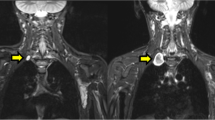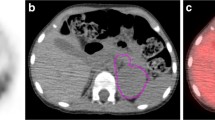Abstract
Background The role of FDG–PET for managing patients with plexiform neurofibromas (PN) is unclear. While many PN tumors exhibit periods of rapid growth, others grow slowly or unpredictably and may have periods of relative quiescence. The ability to predict which PN are likely to progress should facilitate a more timely initiation of medical treatments. Since conventional radiographic techniques have limited prognostic value, the use of a functional imaging modality to predict tumor progression is desirable. We hypothesized that PN tumors with high metabolic activity as demonstrated by FDG–PET are more likely to progress in the following year. Methods All patients were clinically stable, but were considered at high-risk for progression based on anatomical location of PN. FDG–PET scans were performed within two weeks of the baseline MRI study. Standardized uptake values (SUV) were calculated for all focally active index lesions and analyzed for correlation with changes in quantitative MRI over the ensuing year. Results Fifteen of the 18 enrolled patients showed various degrees of FDG uptake as focal abnormalities, and these abnormalities corresponded to those noted on the MRI scans. Thirteen patients and 19 lesions were evaluable for PN volume change. The SUVmax ranged from 0.9 to 4 (median 1.5). There was a significant difference in the percent increase in PN volume in the following year for lesions that had an SUV > 2 compared to those with lower values (P = 0.016). Conclusions These findings support the hypothesis that FDG–PET imaging predicts PN growth rate, and, therefore, may assist clinician decision making with regard to treatment of PN and enrollment in clinical trials.



Similar content being viewed by others
References
Barker D, Wright E, Nguyen K et al (1987) Gene for von Recklinghausen neurofibromatosis is in the pericentromeric region of chromosome 17. Science 236:1100–1102
Viskochil D, Buchberg AM, Xu G et al (1990) Deletions and a translocation interrupt a cloned gene at the neurofibromatosis type 1 locus. Cell 62:187–192
Wallace MR, Marchuk DA, Andersen LB et al (1990) Type 1 neurofibromatosis gene: identification of a large transcript disrupted in three NF1 patients. Science 249:181–186
Korf BR (1999) Plexiform neurofibromas. Am J Med Genet 89:31–37
Dombi E, Solomon J, Gillespie AJ et al (2007) NF1 plexiform neurofibroma growth rate by volumetric MRI: relationship to age and body weight. Neurology 68:643–647
Hoh CK, Hawkins RA, Glaspy JA et al (1993) Cancer detection with whole-body PET using 2-[18F]fluoro-2-deoxy-D-glucose. J Comput Assist Tomogr 17:582–589
Moog F, Bangerter M, Diederichs CG et al (1997) Lymphoma: role of whole-body 2-deoxy-2-[F-18]fluoro-D-glucose (FDG) PET in nodal staging. Radiology 203:795–800
Wong TZ, van der Westhuizen GJ, Coleman RE (2002) Positron emission tomography imaging of brain tumors. Neuroimaging Clin N Am 12:615–626
Adler LP, Blair HF, Makley JT et al (1991) Noninvasive grading of musculoskeletal tumors using PET. J Nucl Med 32:1508–1512
Ferner RE, Lucas JD, O’Doherty MJ et al (2000) Evaluation of (18)fluorodeoxyglucose positron emission tomography ((18)FDG PET) in the detection of malignant peripheral nerve sheath tumours arising from within plexiform neurofibromas in neurofibromatosis 1. J Neurol Neurosurg Psychiatry 68:353–357
Kern KA, Brunetti A, Norton JA et al (1988) Metabolic imaging of human extremity musculoskeletal tumors by PET. J Nucl Med 29:181–186
Lodge MA, Lucas JD, Marsden PK et al (1999) A PET study of 18FDG uptake in soft tissue masses. Eur J Nucl Med 26:22–30
Molloy P, Defeo R, Hunter J et al (1999) Excellent correlation of FDG–PET imaging with clinical outcome in patients with neurofibromatosis type 1 and low grade astrocytomas. J Nucl Med 40:129P
Schulte M, Brecht-Krauss D, Heymer B et al (1999) Fluorodeoxyglucose positron emission tomography of soft tissue tumours: is a non-invasive determination of biological activity possible? Eur J Nucl Med 26:599–605
Solomon J, Warren K, Dombi E et al (2004) Automated detection and volume measurement of plexiform neurofibromas in neurofibromatosis 1 using magnetic resonance imaging. Comput Med Imaging Graph 28:257–265
Basu S, Zaidi H, Houseni M et al (2007) Novel quantitative techniques for assessing regional and global function and structure based on modern imaging modalities: implications for normal variation, aging and diseased states. Semin Nucl Med 37:223–239
Aoki J, Watanabe H, Shinozaki T et al (2001) FDG PET of primary benign and malignant bone tumors: standardized uptake value in 52 lesions. Radiology 219:774–777
Feldman F, van Heertum R, Manos C (2003) 18FDG PET scanning of benign and malignant musculoskeletal lesions. Skeletal Radiol 32:201–208
Ruggieri M (1999) The different forms of neurofibromatosis. Childs Nerv Syst 15:295–308
Huson SM, Harper PS, Compston DA (1988) Von Recklinghausen neurofibromatosis. A clinical and population study in south-east Wales. Brain 111(Pt 6):1355–1381
Tonsgard JH, Kwak SM, Short MP et al (1998) CT imaging in adults with neurofibromatosis-1: frequent asymptomatic plexiform lesions. Neurology 50:1755–1760
Waggoner DJ, Towbin J, Gottesman G et al (2000) Clinic-based study of plexiform neurofibromas in neurofibromatosis 1. Am J Med Genet 92:132–135
Evans DG, Baser ME, McGaughran J et al (2002) Malignant peripheral nerve sheath tumours in neurofibromatosis 1. J Med Genet 39:311–314
Needle MN, Cnaan A, Dattilo J et al (1997) Prognostic signs in the surgical management of plexiform neurofibroma: the children’s hospital of Philadelphia experience, 1974–1994. J Pediatr 131:678–682
Basu S, Nair N (2006) Potential clinical role of FDG–PET in detecting sarcomatous transformation in von Recklinghausen’s disease: a case study and review of the literature. J Neurooncol 80:91–95
Chander S, Westphal SM, Zak IT et al (2004) Retroperitoneal malignant peripheral nerve sheath tumor: evaluation with serial FDG–PET. Clin Nucl Med 29:415–418
Otsuka H, Graham MM, Kubo A et al (2005) FDG–PET/CT findings of sarcomatous transformation in neurofibromatosis: a case report. Ann Nucl Med 19:55–58
Solomon SB, Semih Dogan A, Nicol TL et al (2001) Positron emission tomography in the detection and management of sarcomatous transformation in neurofibromatosis. Clin Nucl Med 26:525–528
Brenner W, Friedrich RE, Gawad KA et al (2006) Prognostic relevance of FDG PET in patients with neurofibromatosis type-1 and malignant peripheral nerve sheath tumours. Eur J Nucl Med Mol Imaging 33:428–432
Cardona S, Schwarzbach M, Hinz U et al (2003) Evaluation of F18-deoxyglucose positron emission tomography (FDG–PET) to assess the nature of neurogenic tumours. Eur J Surg Oncol 29:536–541
Avril NE, Weber WA (2005) Monitoring response to treatment in patients utilizing PET. Radiol Clin North Am 43:189–204
Kostakoglu L, Goldsmith SJ (2003) 18F-FDG PET evaluation of the response to therapy for lymphoma and for breast, lung, and colorectal carcinoma. J Nucl Med 44:224–239
Westerterp M, van Westreenen HL, Reitsma JB et al (2005) Esophageal cancer: CT, endoscopic US, and FDG PET for assessment of response to neoadjuvant therapy–systematic review. Radiology 236:841–851
Acknowledgements
The authors thank Huaqing Zhao for statistical support and Geming Li for assistance with PET analysis. This study was funded by a Young Investigator Award (M.J.F.) from the Children’s Tumor Foundation and a grant from the Joseph Stokes Research Institute at the Children’s Hospital of Philadelphia. Avital Cnaan is supported by a grant from the National Cancer Institute (CA15488).
Author information
Authors and Affiliations
Corresponding author
Rights and permissions
About this article
Cite this article
Fisher, M.J., Basu, S., Dombi, E. et al. The role of [18F]-fluorodeoxyglucose positron emission tomography in predicting plexiform neurofibroma progression. J Neurooncol 87, 165–171 (2008). https://doi.org/10.1007/s11060-007-9501-5
Received:
Accepted:
Published:
Issue Date:
DOI: https://doi.org/10.1007/s11060-007-9501-5




